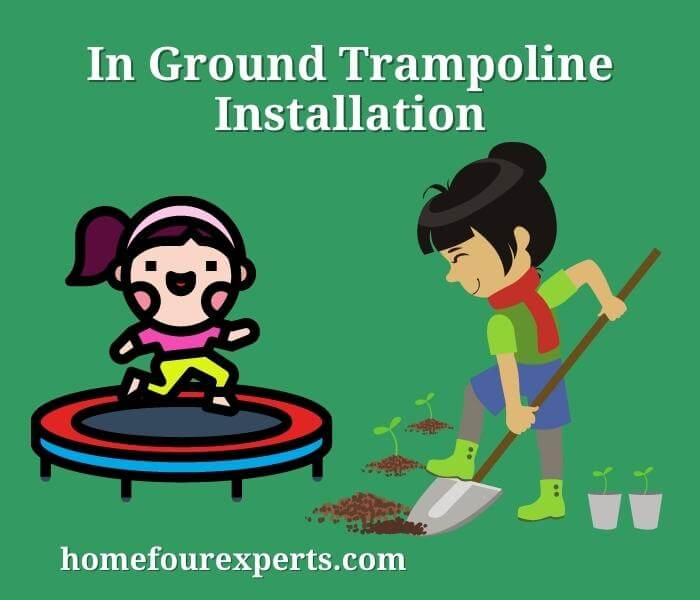People love trampolines for many reasons as it helps in many ways such as encouraging kids to play outside, reducing stress, improving the Lymphatic system, strengthen heart rate, and much more.

Many trampoline lovers tend to install their trampoline in the ground as it saves backyard space and doesn’t show extra substance on the ground but they often make the installation process for not having the proper knowledge about installing in-ground trampoline.
The followings are some guidance on installing an in-ground trampoline in the right way.
Dig The Hole According To The Trampoline Shape
Before digging a hole measure up what shape and size trampoline you want to install. The size and shape of a trampoline depend on the space available in your backyard. If the trampoline size is bigger than the suitable space it would be a massive destruction instead of installation. To make the installation process safe you should measure the trampoline size.
When you finish the measuring process, digging the outer hole a few inches wider than the trampoline size will help you to put the trampoline in the hole easily.
Firstly, dig out 20 to 25cm of soil across the entire hole which will be the first layer. Then again dig out the inner soil in the middle in a bowl shape that is the second layer. The depth of the inner hole depends on the size of the trampoline. Dig out 9cm inner soil for a 12 to 14ft round trampoline and 75cm for an 8 to 10ft round trampoline.
If the trampoline is rectangular in shape then dig out 75cm of inner soil for 10×6ft and 11×8ft size trampolines. And for a 14×10ft rectangular trampoline dig out 90cm of inner soil.
Create a Retaining Wall
The retaining wall will help to stop collapsing dirt into the pit. If there is no retaining wall used for the trampoline then the dirt will pour into the hole and minimize the depth of the inner hole. A Parament retaining wall made of concrete is much better than a sheet or metal retaining wall. If you want to have your trampoline permanently sink in the ground then you can set a permanent retaining wall only.
Keep a Drainage System
This is very important to keep a drainage system under the trampoline. Make the drainage system When you make the retaining wall. If you do not have a proper drainage system to remove the water from the pit then it will cause rust to the retaining wall and trampoline frame. To soak up the water from the pit you can make a soakaway using Perforated drainage pipes in the bottom of the pit or creating a whole in the retaining wall for installing the pipe.
Keep Ventilation System
This is one of the biggest mistakes while installing an in-ground trampoline. Air movement is a must to get the best result of an in-ground trampoline. When people jump on a trampoline air needs to flow freely in and out of the hole. If there is no ventilation system for air movement then the trampoline mat would become a hard surface instead of a soft jumping mat. When you attach the pads to the trampoline to cover up the spring use a vented pad that can easily flow the air.
Assemble the Trampoline Frame

When the hole is prepared assemble the frame of your trampoline. First, start from the bottom section and assemble the legs of the trampoline. Then attach the mat with the spring. If you are using a permanent retaining wall then you don’t need to attach it to the frame but for a temporary retaining wall, you can attach sheet or metal substances with the trampoline frame.
Place the Trampoline Into the Hole
When you are done with the assembling process, put the trampoline into the hole you made in the ground. You can turf the area to keep the edges at the same level as the ground surface.
Other Things to Consider for Installing In Ground Trampoline
An in-ground trampoline requires more maintenance than an above-ground trampoline. If you install an inground trampoline you need to check the water under the mat, the usability of the springs, the Durability of the jumping mat, and the condition of the frame.
In-ground trampoline costs more money and requires more time than the on-ground trampoline. And the most considerable thing for an in-ground trampoline is its water drainage system.
Some people think ground trampolines do not need any net for preventing the danger of falling. But still, they should consider using a net for the trampoline.
This installation process can help you to set up your desired ground trampoline. Remember, the ground trampoline is safer but you need to check and maintain the trampoline to enjoy safe trampoline activities.
Type of Maintenance is Needed for an in-ground Trampoline Installation
In-ground trampoline installations require regular maintenance such as checking the condition of the frame, springs, and mat; regularly checking the bolts, nuts, and screws; and checking the condition of the surrounding area. It is also important to inspect the safety net and surrounding enclosure for wear and tear.
The area around the trampoline should be regularly cleared of debris, and the trampoline should be inspected for tears, holes, or other damage.
Conclusion
Ground Trampoline Installation can be a great way to add a fun and safe bounce space to your outdoor area. It is an excellent choice if you want to enjoy the benefits of a trampoline, while also having it blend into the look of your outdoor space. It does require a bit of effort to install, so it’s important to consider the costs and labor involved in the process.
Read More:
About This Writer

Guys, I am Camila Avery and I love to help my mom to do indoor & outdoor activities. As a lady, I have passed my time on gardening, home improvement, and personal or self-care. I have acquired some degrees in outdoor recreation, beauty, and hair care. It is not easy to work with top-level professional beauty experts. But, I got that opportunity and experimented with different hair extensions, hair colors, and cuts.